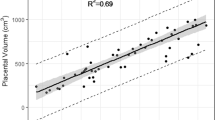Abstract
Fetal growth restriction (FGR) is common, affecting around 10% of all pregnancies. Growth restricted fetuses fail to achieve their genetically predetermined size and often weigh <10th centile for gestation. However, even appropriately grown fetuses can be affected, with the diagnosis of FGR missed before birth. Babies with FGR have a higher rate of stillbirth, neonatal morbidity such as breathing problems, and neurodevelopmental delay. FGR is usually due to placental insufficiency leading to poor placental perfusion and fetal hypoxia. MRI is increasingly used to image the fetus and placenta. Here we explore the use of novel multi-compartment Intravoxel Incoherent Motion Model (IVIM)-based models for MRI fetal and placental analysis, to improve understanding of FGR and quantify abnormalities and biomarkers in fetal organs. In 12 normally grown and 12 FGR gestational-age matched pregnancies (Median 28\(^{+4}\)wks±3\(^{+3}\)wks) we acquired T\(_{2}\) relaxometry and diffusion MRI datasets. Decreased perfusion, pseudo-diffusion coefficient, and fetal blood T\(_{2}\) values in the placenta and fetal liver were significant features distinguishing between FGR and normal controls (p-value <0.05). This may be related to the preferential shunting of fetal blood away from the fetal liver to the fetal brain that occurs in placental insufficiency. These features were used to predict FGR diagnosis and gestational age at delivery using simple machine learning models. Texture analysis was explored to compare Haralick features between control and FGR fetuses, with the placenta and liver yielding the most significant differences between the groups. This project provides insights into the effect of FGR on fetal organs emphasizing the significant impact on the fetal liver and placenta, and the potential of an automated approach to diagnosis by leveraging simple machine learning models.
The first two authors contributed equally.
Access this chapter
Tax calculation will be finalised at checkout
Purchases are for personal use only
Similar content being viewed by others
References
Lyall, F., Robson, S.C., Bulmer, J.N.: Spiral artery remodeling and trophoblast invasion in preeclampsia and fetal growth restriction: relationship to clinical outcome. Hypertension 62(6), 1046–1054 (2013)
Gordijn, S.J., et al.: Consensus definition of fetal growth restriction: a Delphi procedure. Ultrasound Obstet. Gynecol. Official J. Int. Soc. Ultrasound Obstet. Gynecol. (2016)
Gardosi, J., Madurasinghe, V., Williams, M., Malik, A., Francis, A.: Maternal and fetal risk factors for stillbirth: population based study. BMJ (Online) 346(7893) (2013)
Colella, M., Frérot, A., Novais, A.R.B., Baud, O.: Neonatal and long-term consequences of fetal growth restriction. Curr. Pediatr. Rev. 14(4), 212–218 (2018)
Green-top Guideline No. The investigation and management of the small-for-gestational-age fetus (2002)
Melbourne, A., et al.: Separating fetal and maternal placenta circulations using multiparametric MRI. Magn. Reson. Med. 81(1), 350–361 (2019)
Couper, S., et al.: The effects of maternal position, in late gestation pregnancy, on placental blood flow and oxygenation: an MRI study. J. Physiol. (2020)
Aughwane, R., et al.: MRI measurement of placental perfusion and oxygen saturation in early onset fetal growth restriction. BJOG: Int. J. Obstet. Gynaecol. 1471–0528.16387 (2020)
Le Bihan, D., Breton, E., Lallemand, D., Grenier, P., Cabanis, E., Laval-Jeantet, M.: MR imaging of intravoxel incoherent motions: application to diffusion and perfusion in neurologic disorders. Radiology 161(2), 401–407 (1986)
Le Bihan, D.: What can we see with IVIM MRI? Neuroimage 187, 56–67 (2019)
Jerome, N.P., et al.: Extended T2-IVIM model for correction of TE dependence of pseudo-diffusion volume fraction in clinical diffusion-weighted magnetic resonance imaging. Phys. Med. Biol. 61(24), N667 (2016)
Haralick, R.M., Shanmugam, K., Dinstein, H.: Textural features for image classification. IEEE Trans. Syst. Man Cybern. 1(6), 610–621 (1973)
Bharati, M.H., Liu, J.J., MacGregor, J.F.: Image texture analysis: methods and comparisons. Chemometr. Intell. Lab. Syst. 72(1), 57–71 (2004)
Portnoy, S., Osmond, M., Zhu, M.Y., Seed, M., Sled, J.G., Macgowan, C.K.: Relaxation properties of human umbilical cord blood at 1.5 tesla. Magn. Reson. Med. 77(4), 1678–1690 (2017)
Mifsud, W., Sebire, N.J.: Placental pathology in early-onset and late-onset fetal growth restriction. Fetal Diagn. Ther. 36, 117–128 (2014)
Burton, G.J., Woods, A.W., Jauniaux, E., Kingdom, J.C.P.: Rheological and physiological consequences of conversion of the maternal spiral arteries for uteroplacental blood flow during human pregnancy. Placenta (2009)
Mifsud, W., Sebire, N.J.: Placental pathology in early-onset and late-onset fetal growth restriction. Fetal Diagn. Ther. 36(2), 117–128 (2014)
Acknowledgements
This research was supported by the Wellcome Trust (210182/Z/18/Z and Wellcome Trust/EPSRC NS/A000027/1) and the Radiological Research Trust. The funders had no direction in the study design, data collection, data analysis, manuscript preparation or publication decision.
Author information
Authors and Affiliations
Corresponding authors
Editor information
Editors and Affiliations
Rights and permissions
Copyright information
© 2021 Springer Nature Switzerland AG
About this paper
Cite this paper
Zeidan, A.M. et al. (2021). Texture-Based Analysis of Fetal Organs in Fetal Growth Restriction. In: Sudre, C.H., et al. Uncertainty for Safe Utilization of Machine Learning in Medical Imaging, and Perinatal Imaging, Placental and Preterm Image Analysis. UNSURE PIPPI 2021 2021. Lecture Notes in Computer Science(), vol 12959. Springer, Cham. https://doi.org/10.1007/978-3-030-87735-4_24
Download citation
DOI: https://doi.org/10.1007/978-3-030-87735-4_24
Published:
Publisher Name: Springer, Cham
Print ISBN: 978-3-030-87734-7
Online ISBN: 978-3-030-87735-4
eBook Packages: Computer ScienceComputer Science (R0)





